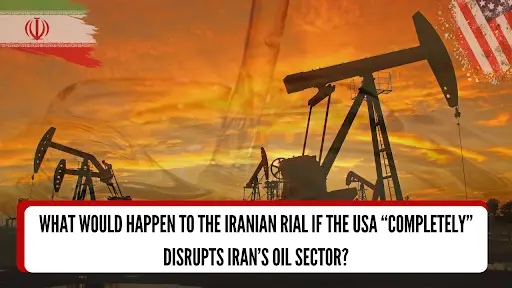
The Iranian Rial is closely tied to the country’s oil revenues, which serve as the primary source of foreign currency inflows and government funding. Any disruption in Iran’s oil sector directly impacts its ability to stabilize the Rial.
If the United States were to completely disrupt Iran’s oil exports, the immediate consequence would be a severe strain on the country’s foreign exchange reserves, triggering rapid currency devaluation, inflation, and widespread economic instability.
Let’s examine the link between Iran’s oil dependency and its currency strength, the potential impact of a complete oil disruption on trade and reserves, internal measures Iran might adopt to counter the collapse, and the broader ripple effects on regional currencies and global markets.
Iran’s economy is heavily dependent on oil and gas exports, which make up a significant portion of government revenue and foreign exchange reserves. Historically, oil exports have contributed around 70% of Iran’s export income, providing the government with the financial resources needed to stabilize the Iranian Rial (IRR). The oil sector is Iran’s economic backbone, and revenue from crude oil sales directly supports currency management by enabling the central bank to hold foreign currencies like the U.S. dollar and the euro.
Whenever there is pressure on Iran’s oil exports—whether through sanctions, reduced global demand, or price volatility—the Iranian Rial faces immediate stress. This is because the supply of foreign currency decreases, reducing the central bank’s ability to support the Rial in foreign exchange markets. The Rial has already suffered from devaluation in recent years due to international sanctions, and any further disruption in oil sales would accelerate this decline.
Despite the severity of such a scenario, Iran has tools and strategies it could employ to manage the crisis and mitigate the collapse of the Rial.
The impact of a complete disruption in Iran’s oil exports would not remain confined within its borders. The regional economy and global markets would feel the consequences.
1. Regional Currency Devaluation: Neighboring countries like Iraq, Turkey, and Pakistan would experience volatility in their own currencies. Trade disruptions with Iran would reduce their export earnings, causing pressure on local currencies. Businesses relying on cross-border commerce would face liquidity shortages.
2. Smuggling and Black Market Growth: As Iran’s official economy contracts, illegal trade would surge. Smuggling routes along Iran’s borders with Pakistan, Afghanistan, and Turkey would flourish. Fuel, consumer goods, and pharmaceuticals would be smuggled into Iran, distorting prices in neighboring countries and fueling corruption.
3. Geopolitical Tensions and Instability: The weakening of Iran’s economy could lead to greater political instability in the region. Iran might respond with aggressive regional policies or increased involvement in conflicts to deflect attention from domestic problems. This could heighten tensions in the Persian Gulf and increase risks for global oil transport routes.
4. Volatility in Global Oil Prices: A reduction in Iranian oil supply could trigger a surge in global oil prices. Although the United States and its allies might attempt to stabilize supply through increased production from other countries, uncertainty and geopolitical risks could drive prices higher, affecting inflation worldwide.
5. Economic Impact on Key Trade Partners: Countries heavily reliant on Iranian oil—such as China and India—would need to secure alternative sources. This could lead to higher costs for these nations and disruptions in their energy security strategies.
A complete U.S. disruption of Iran’s oil sector would undoubtedly create an economic crisis. The Iranian Rial would come under extreme pressure, leading to rapid depreciation, inflation, and economic instability. Public confidence in the currency would erode, and the domestic economy would face severe contraction.
However, Iran’s past experience with sanctions and economic challenges has made it resilient. The country’s government has already developed alternative mechanisms to reduce its vulnerability to oil revenue shocks. While these measures may not fully compensate for the loss of oil exports, they could soften the blow and help the country manage a gradual decline rather than suffer an immediate economic collapse.
The real outcome would depend on the scale of disruption and Iran’s ability to adapt. In the short term, life for ordinary Iranians would become increasingly difficult. In the long term, the government’s ability to stabilize the situation would hinge on its access to alternative trade channels, the effectiveness of internal controls, and geopolitical support from allied nations.
For the region, the scenario would mean increased volatility, with potential currency devaluations in neighboring states, expanded black markets, and a higher risk of geopolitical instability. Global oil markets would react with price fluctuations, impacting economies far beyond the Middle East.
While the disruption of Iran’s oil sector would undoubtedly be a catastrophic shock to its economy, Iran’s ability to implement strict domestic controls, leverage barter trade agreements, and seek support from geopolitical allies could prevent total collapse. However, such measures would likely lead to a prolonged period of severe economic hardship, characterized by high inflation, currency instability, and reduced living standards.
The Iranian rial’s future hinges on whether the country can achieve meaningful diversification and diplomatic breakthroughs to alleviate sanctions—without these, a controlled decline rather than complete devastation seems the more probable outcome.
End

Id quam fames at eget pede. Mauris tellus hac pellentesque tincidunt vestibulum.